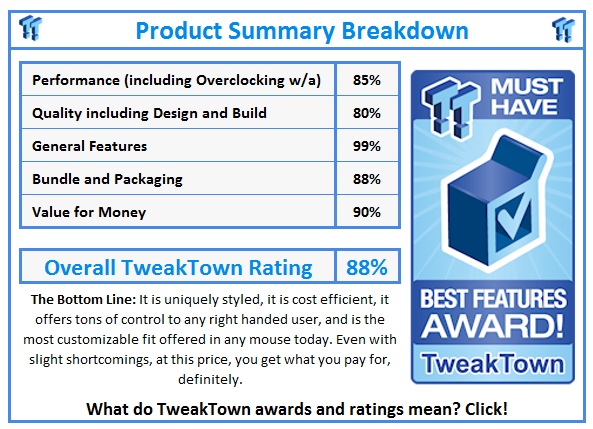Introduction, Specifications and Pricing
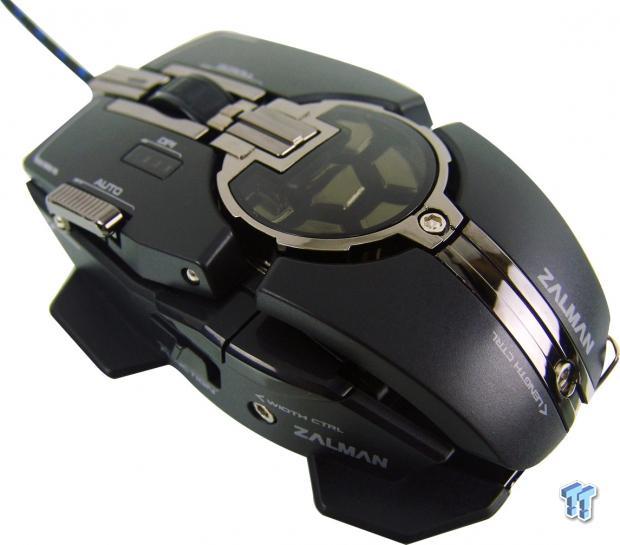
We all know that Zalman is known for CPU and VGA coolers, and even for cases and other oddities that can inhabit the office or gamers sanctuary, but what we had not really paid any attention to over the past five or so years, is the development of Zalman peripherals. It wasn't until we saw a post on social media of this mouse's release that we even went to check out Zalman's peripheral offerings. Boy were we surprised. Not only do they currently offer something like eleven mice, including this sample, but they also have a couple of mouse pads, as well as a half a dozen keyboards to offer the market.
We always try to go back to the site and see where a design got its lines, features, components, as well as where newer design implementations may have come from. With this mouse, it is not hard at all to see that it takes a lot of its aesthetic appeal from its predecessors, and over the years, the design has been fine tuned with an ear to the gaming scene in order to offer a laser mouse that is everything you could want in a mouse. At least that is what Zalman hopes this mouse will be. In this instance, Zalman must have heard that people like the design and implementation of adjustable panels; that's right, sort of like the EVGA TorqX10, but on a whole other level. But we are getting a bit ahead of ourselves here.
We're going to have to take a step back, and try not to spill the excitement of what Zalman has brought forth with their newest mouse, the Knossos ZM-GM4 Professional Laser Gaming Mouse. This mouse does in fact have three adjustable panels incorporated into the design to help it adjust to fit the hands of even the largest gamers out there. However, outside of that, Zalman doesn't really follow conventional designs, and with one glance at this new mouse, it is easy to see the same concepts that have made Zalman a household name is not lost in their peripherals.
If what we have addressed so far has not interested you yet, you may want to check for a pulse, because while it's certainly not the first adjustable mouse on the planet, Zalman does it in a way that takes this design to new levels. This adjustable design is something we can already see people taking and running away with on their own designs. If that still hasn't gotten your attention, give us just a couple of pages, and we will definitely have your attention then.
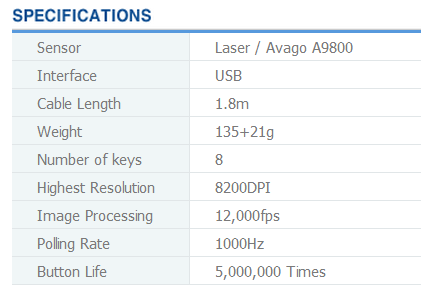
The chart provided by Zalman touches on all of the basics, but that is really about it. Built into the ZM-GM4, we find an Avago ADNS A9800 laser sensor that will allow a DPI range of 200 to 8200, with adjustments of 100 DPI increments. We see this is a USB mouse, which is sort of a no-brainer since it has been years since a PS2 mouse has been reviewed. The USB cable is braided in black and blue cloth, and is 1.8 meters in length from the mouse to the gold plated connection. The mouse weighs in at 135 grams without weights, and offers 21 grams of additional weight over six gold, removable chunks of metal.
We are also shown that there are eight buttons on the mouse, there is a limit of 12,000 fps imaging processing, a 1000Hz polling rate, and this mouse offers a five million click lifespan in the Omron switches under the right and left-click buttons. If we were writing this chart, we would have addressed things like the mouse's dimensions, or at least the adjustability of them.
There is not one truly normal surface on this design. The right and left-click buttons, and the scroll wheel are set into their own section. Behind that, there is the DPI button, and a clear circular section where the weights can be added or taken away. At the back of the mouse is the heel section, which is adjustable in length, but it also rises in height as it moves back. If that isn't enough, both sides of this uniquely designed mouse also adjust quite a bit, so skinny, wide, short, or long hands can all find a comfortable setup for use.
Outside of that, you are given a mostly plastic mouse that is primarily black. There are instructions, denotations, and naming painted in gray on all of the sections, and if that wasn't enough for aesthetics, there is also a generous use of black nickel plating to dress things up, and add body lines and styling to the design.
As we are writing this, the ZM-GM4 is still quite new, and being as such, it is tough to find at the moment. In fact, as far as inside of the USA is concerned, there is only one location currently offering stock of this mouse, and it happens to be Newegg.com. The best part about locating the Knossos ZM-GM4 was that we found it listed for a mere pittance of $58.99. We do see that the normal price is a bit higher, five dollars in fact, but even at that price, you certainly get a lot of mouse for your dollar. If you still aren't sure about the ZM-GM4, we strongly urge you to continue along with this article, because images do more for this product than anything we could type out.
PRICING: You can find the Zalman Computer Adjustable Laser Gaming Mouse (ZM-GM4) for sale below. The prices listed are valid at the time of writing but can change at any time. Click the link to see the very latest pricing for the best deal.
United States: The Zalman Computer Adjustable Laser Gaming Mouse (ZM-GM4) retails for $69.99 at Amazon.
Packaging
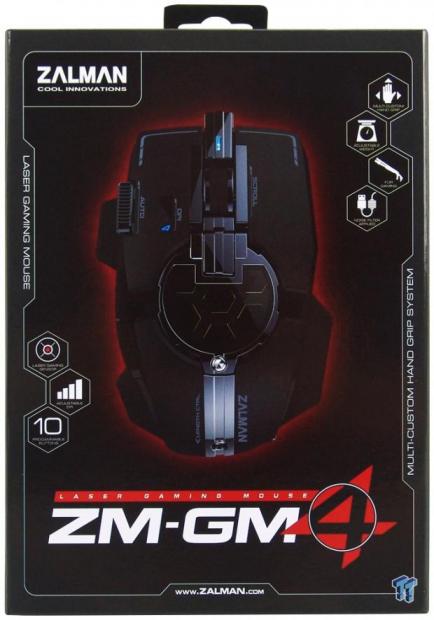
The packaging of the ZM-GM4 is pretty thorough for the limited area a mouse box offers. Of course, we see the mouse front and center, but around it are seven icons denoting features found in the design. At the bottom they address the product naming, and offer the web address, but to the right, they even spell out the multi-custom hand grip system in this design.
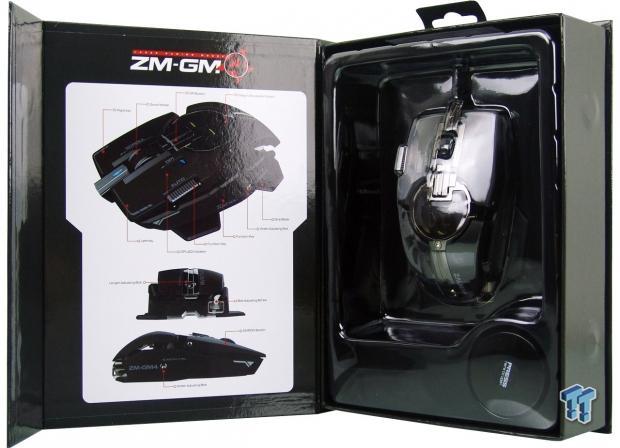
The front of the packaging will open up once the pair of magnets on the side are released. Inside of the lid we find an image of the mouse we can plainly see at the right. Multiple angles are used to point out all of the buttons, adjustment points, and where the onboard tool is located.

Since both of the side panels are identical, we will only show one of them. On this panel there is simply the company name in smaller text, with the product naming in a much bigger font, taking up the bulk of the panel.
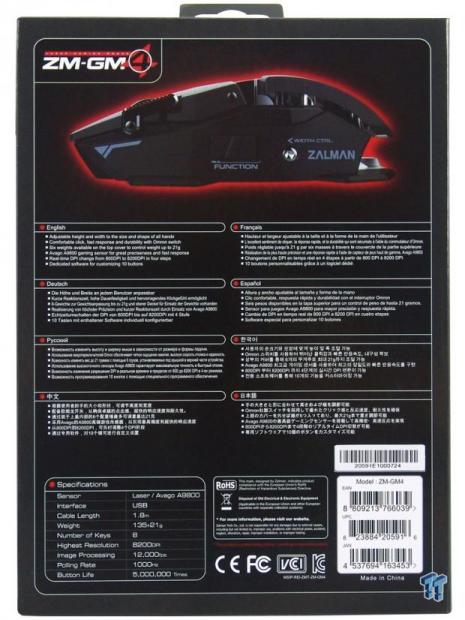
On the back we start with another image of the ZM-GM4, but below that image there are six features listed (in eight different languages) that are contained in, or on, this design. Under those, we see the same specifications list we just covered earlier.
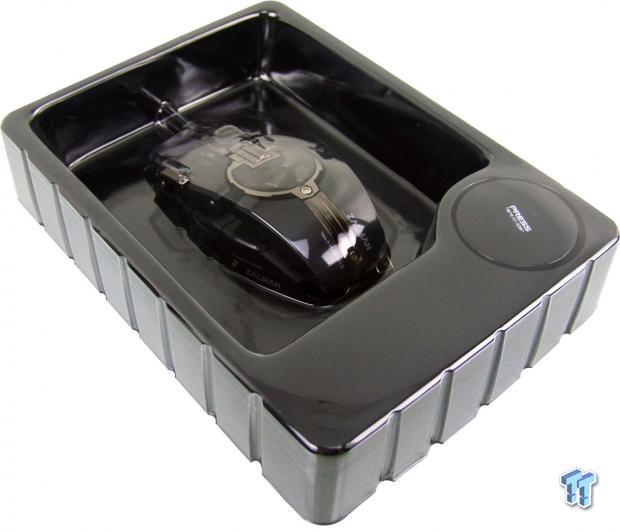
Inside of the cardboard, after lifting the lid, you can remove the two-part plastic inner packaging. This keeps the mouse in place, and also offers solid protection against potential damages during transit. We can also see the lid of a little tin to the right, while the rest of the paperwork and accessories can be found beneath.
Zalman Knossos ZM-GM4 Professional Laser Gaming Mouse
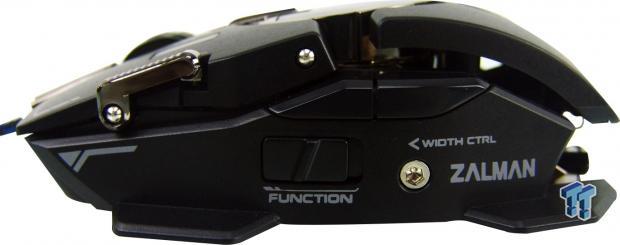
Starting with a look at the left side of the ZM-GM4, we can see there is a lot going on. Across the top edge, there is the nickel plated "auto," or a double-click button, and to the right of that there are black page forward and page back buttons. Below those, there is a "function" button to open a browser, and just to the right of that there is a screw head that, as the paint implies, offers width control for this side.
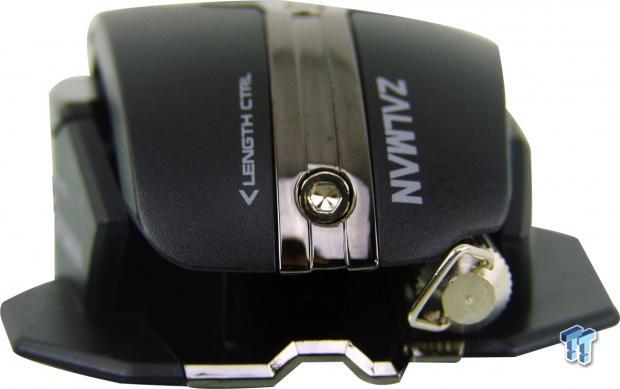
Looking at it from the back, you can more easily see the ledges to the sides that are cut away in the middle, which give this mouse a much wider footprint for stability. Amongst the textured plastic, we can also see there is more nickel plating down the center, surrounding the length adjustment screw, and in the metal section of the base. Lastly, you can see just the head of the onboard tool that makes those adjustments.
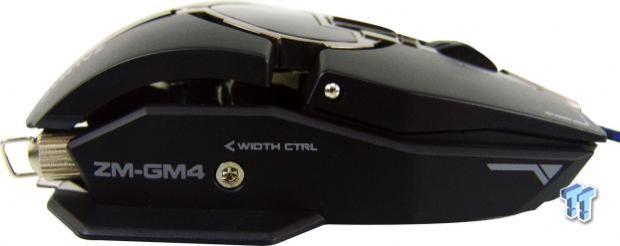
The right side is much more simplistic. Here we find the side is separated just like at the left, and just after the ZM-GM4 naming, we find the last screw that will allow this side to expand outward for the last bit of the customizable fit this mouse offers.
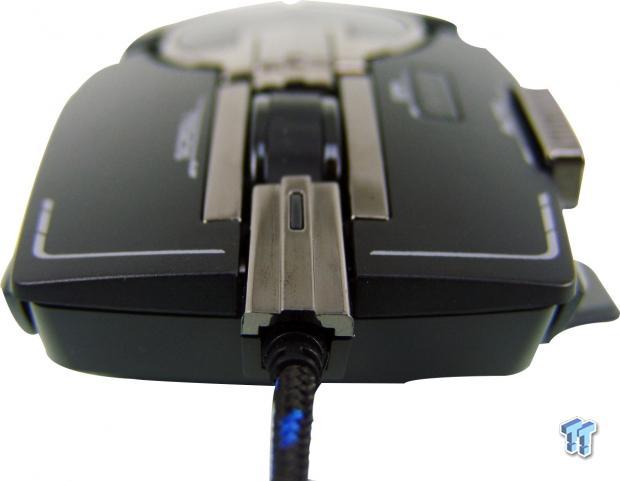
Staring down the front of the ZM-GM4, we can see that the nickel trim we saw at the back runs from front to back, separating the halves of the mouse. The buttons are ever so slightly longer than the base of the mouse, and there is a large, chunky support around the entry to the braided USB 2.0 cable.
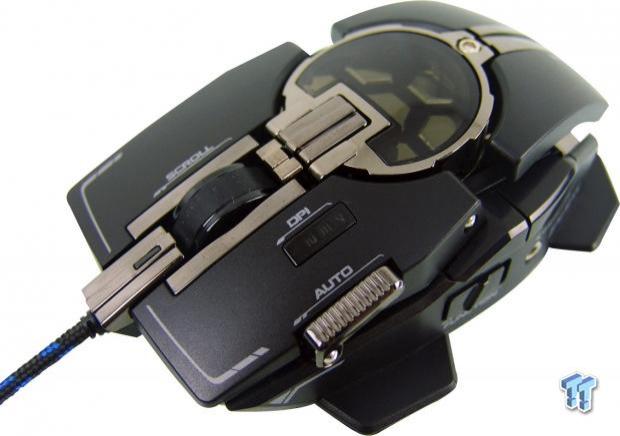
Stepping back a bit to get the top in full view, we see things like the rubberized scroll wheel for extra grip, and a LED in front of the wheel that illuminates when in motion. Behind that is a button for DPI selection; the DPI is illuminated with levels indicating one through four. Lastly, we can see the tinted window over the weighting system.
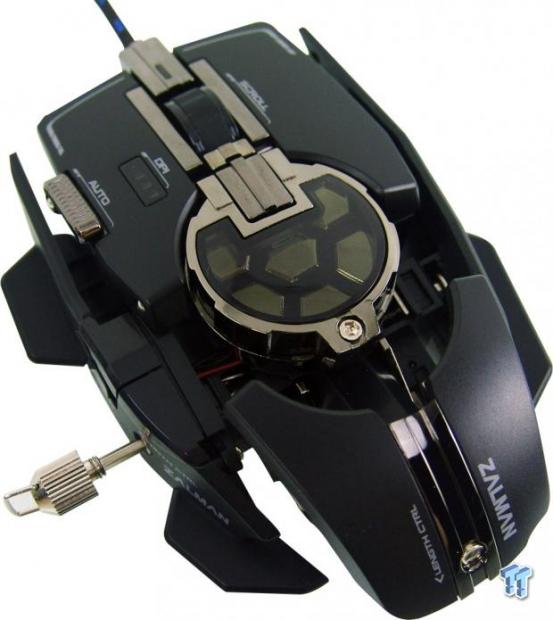
At this point we have removed the 3/32 Allen wrench from the heel of the mouse; then, by unscrewing all three screws, we can now see the Knossos in her full-sized form. We did find the tool to be handy, but it is tough to use because it is so short, and the odd handle that runs through the head of it does not help much either.
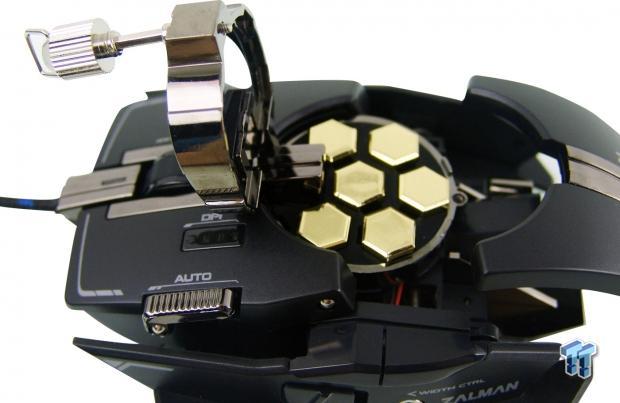
That same wrench will also unscrew the cover for access to the adjustable weights. Under the cover is where six gold, hexagonally shaped, 3.5 gram weights are stored. This will allow users to play with the weighting, and even offset the weight to one side or the other, or front to back for that matter.
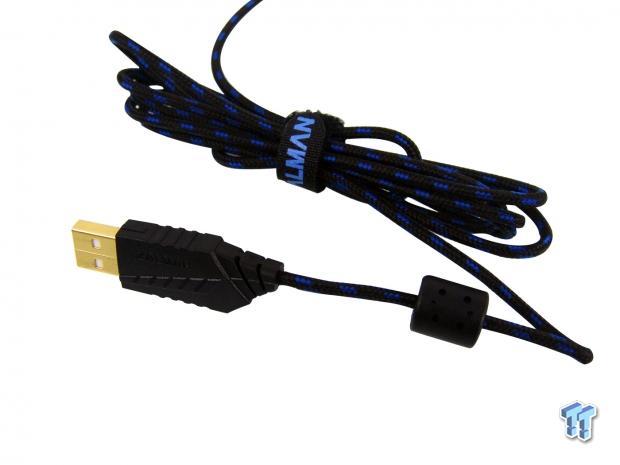
The blue and black braided covering is a nice change of pace, and it also matches the LEDs under the DPI notification, and the light at the front. At the end of this 1.8 meter cable, we find a stylized cover on the gold plated connection. We also get a Velcro tie strap to help maintain the wiring for transit, or at the desktop.
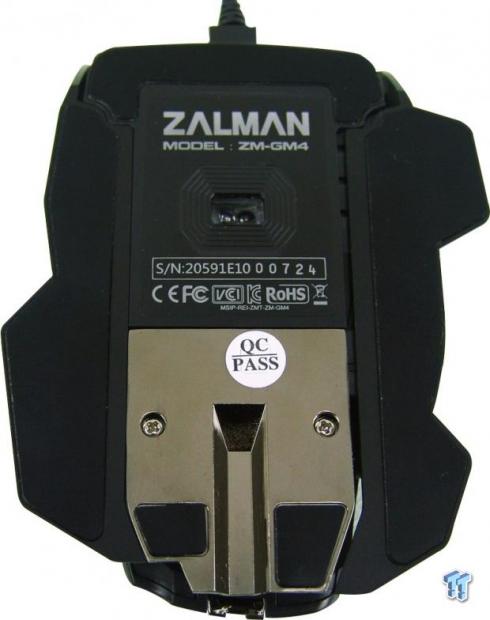
As we look under the mouse, we find the sensor pushed to the front edge of this design. To allow this eye to slide easily around on the pad it is tracking, Zalman uses a combination of five different sized feet around the outside of the form.
Accessories and Documentation
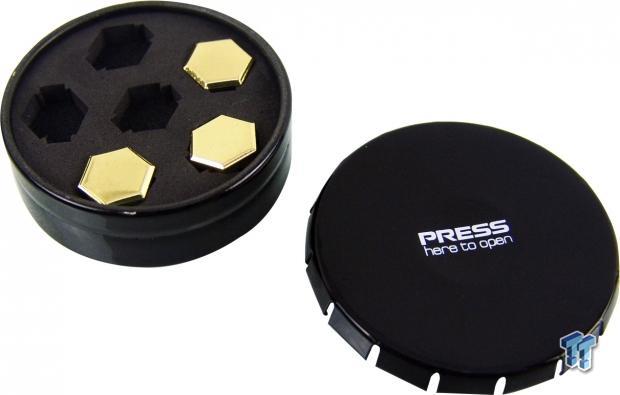
Going back to the packaging, we mentioned a tin that was below the mouse, and here it is. As the print suggests, you push down on the top, and expand the side tabs to remove the cap. Inside is a foam block that will hold any excess weights you may wish to omit from the mouse. To close the tin, place the lid on, press on the sides, and the tabs will retract and grab the base of the tin. The seal is relatively tight, so the weights won't accidentally fall out.
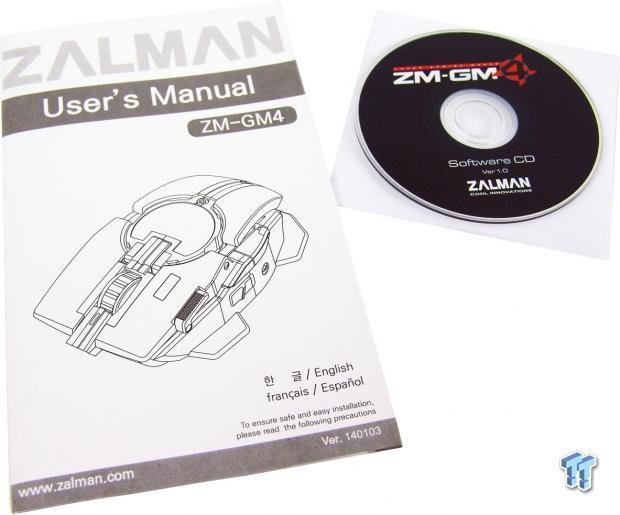
We also find a user's manual that will offer you information on everything from button layout and functionality, to a look at the software and beyond. We also find a mini-disk with version 1.0 of their software, which is the latest software version currently offered via download at Zalman.
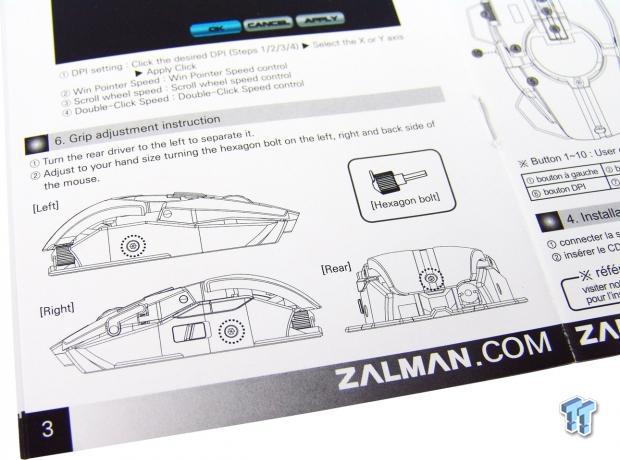
Since the grip adjustment is what really makes this design unique, there is a section on the grip adjustment to make sure there is no confusion. Here we can see they show you the tool and how to remove it, and they also point out the three locations where you can widen and lengthen the fit of the ZM-GM4.
Inside the Knossos ZM-GM4

We would strongly suggest that you do not attempt to open this mouse; there is much more involved than just pulling a few screws to clean it out.
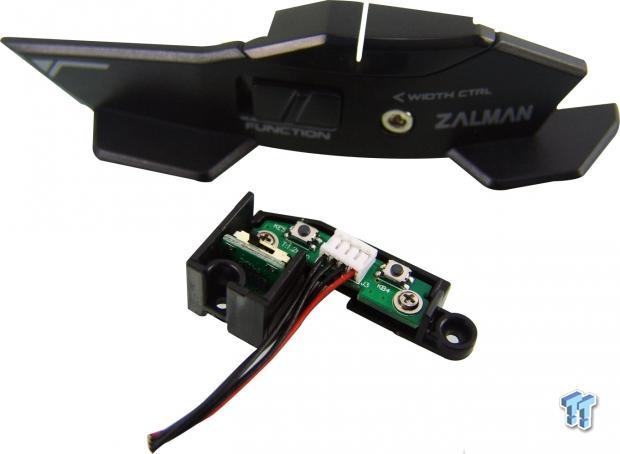
Inside of the last panel of the ZM-GM4, we found a PCB containing two pad switches to back the page forward and page back buttons. Off to the left is a slider style switch that adds a stiff feel to the "function" button.
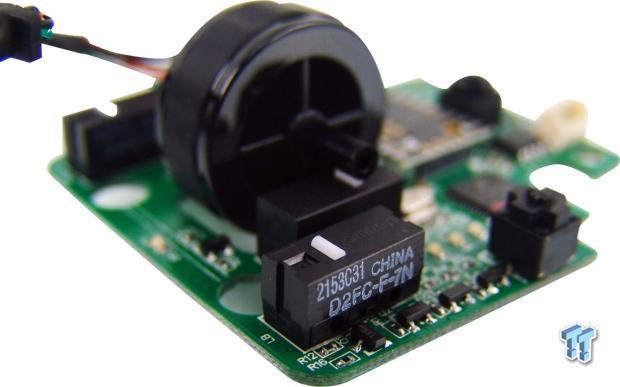
After carefully lifting the main PCB out of the frame, we get a much better view of the left-click switch. We found it to be backed by the five million click versions of the Omron D2FC-F7N switches, which offer a softer feel with an audible click.
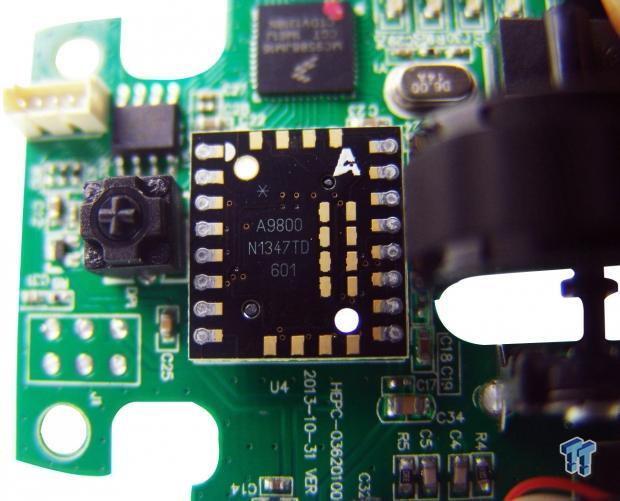
In the center we have the Avago ADNS A9800 laser sensor as the heart of the system. This top-tier sensor has been proven time and time again to be issue free with the right firmware, and will give you more DPI than you will know what to do with. The switch off to the left is the "auto" button's pad switch.
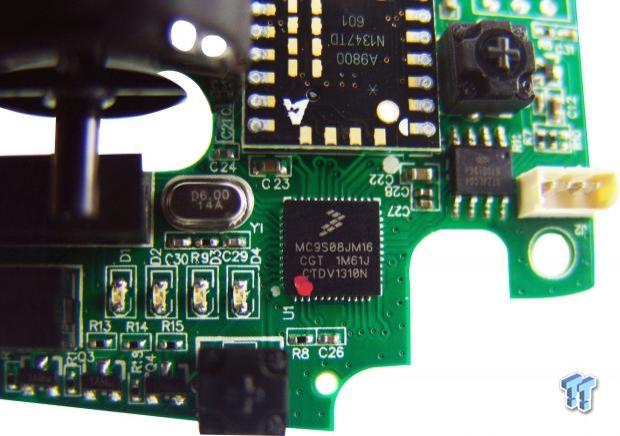
If the laser sensor is the heart, then the Freescale MC9S08JM16 MCU used in this system is definitely the brains. This is where all the signals pass through to be processed and sent out though the USB 2.0 end of this IC.
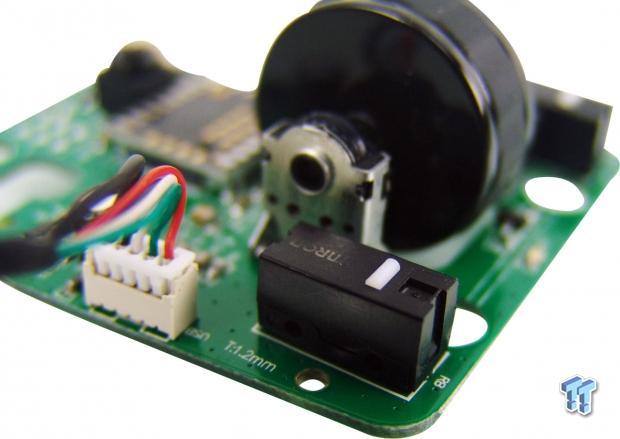
As we spin around to the other side of the scroll wheel, we find a matching Omron switch under the right-click button, also offering a five million click lifespan.
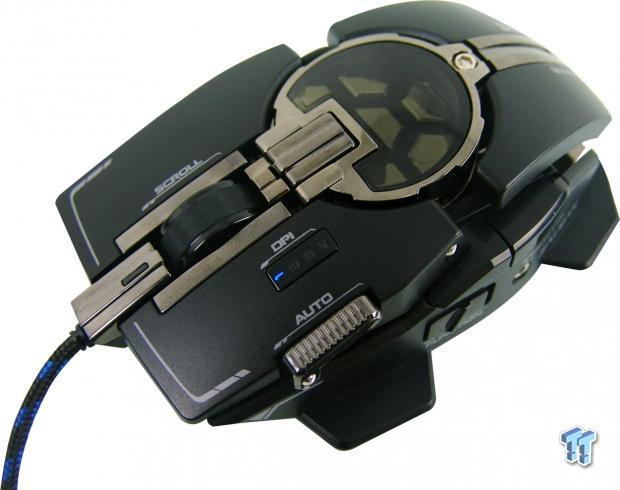
After a fair bit of reassembly, we now have the Knossos ZM-GM4 back in once piece, and powered up. The LEDs to the left of the scroll wheel denote we have the DPI in setting one of four. Also, just behind where the cable enters the mouse, there is a slim panel in the nickel plated section that will also glow with a blue LED, but only when the mouse is in motion.
Software
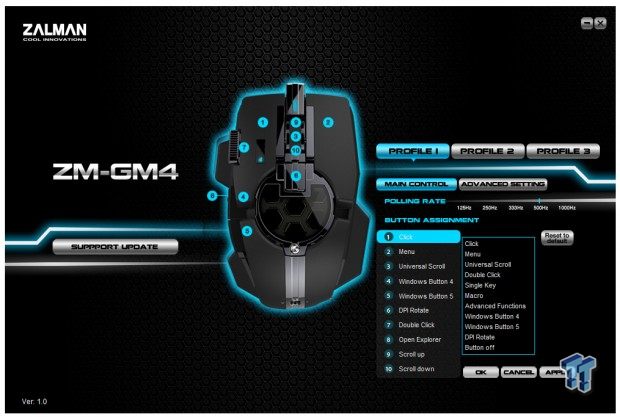
Once the GM4 drive is installed, an icon will appear in the task manager. Right-clicking the icon, and then clicking on configure brings this up on the screen. Under the name there is a support update button that takes you to www.zalman.com, where you can search for new drivers. The center has an image of the mouse, with all of the optional things that can be moved around, or even used for Macros and other advanced features to make this mouse work for you, and not the other way around, as the dropdown box shows. This is also where you address the polling rate, and have the option to reset the settings to default.
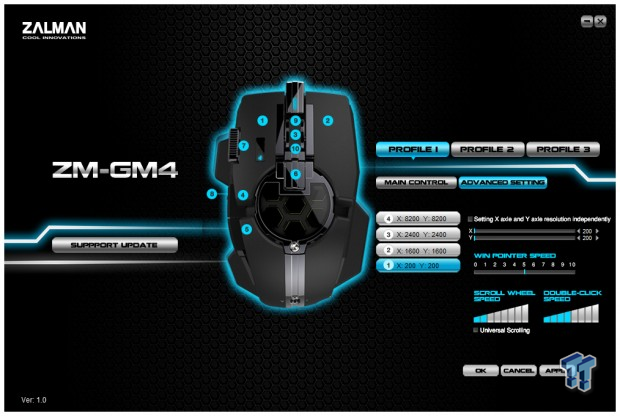
In the advanced controls section, you now have access to four settings of DPI levels to correspond to the four lights found on the top of the ZM-GM4. The DPI can be adjusted independently if desired; you can address the pointer speed, scroll speed, double-click speed, and there is also an option for universal scrolling, to enable scroll wheel control in applications that do not have native support.
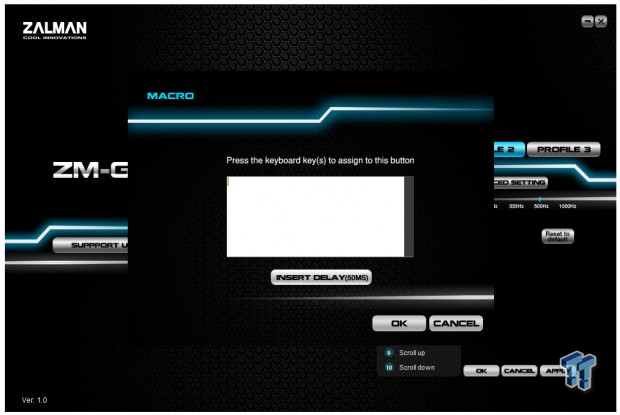
If you click on the Macro selection in the dropdown menu for the buttons, you will be given this window so that you may attempt to set up a Macro. We found it hard to set up, limited in the amount of characters that can be used, and it had no options to import others that may already be saved. We have seen much better offerings when it comes to Macro support.
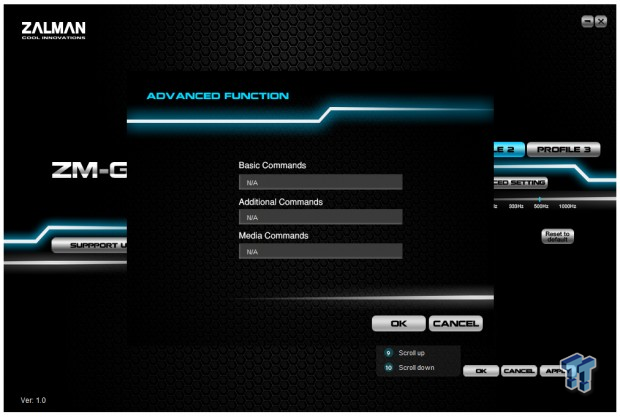
There are advanced functions to address as well. There are three groups to choose from to help simplify the lists. Basic commands offer things like cut, copy, paste, undo, select all, find, new, and save. Then under the additional commands, we find swap window, close window, my computer, run, and show desktop. Media commands offer all of the functionality that we see on most keyboards. Any of these can be set to any button across the three profiles, essentially allowing for twenty-nine other functions the mouse can do other than the left-click function (which must be there in one of the profiles).
Final Thoughts
Quite a list of things comes to mind when it comes to design implementations and the choice of components used in the ZM-GM4 from Zalman. We like the basic aesthetics with the irregular shapes, funky side wing supports, and the custom adjustability to fit your hand. Even down to all the black nickel plating, this mouse is just stunning to look at. Some may say it looks like a RAT mouse, and some may say EVGA was first with an adjustable system, but as we said before, Zalman takes "cool innovations," and hits the nail right on the head. It tracks well, feels good when the comfort grip system is adjusted properly, and it will fit the smallest and some of the largest hands out there in need of a new mouse.
With all of the flash and adjustability, the ZM-GM4 does have a couple of stumbling points in our opinion. First, we will address the motion sensitive LED. Although it is cool, who looks at the mouse while it is moving? We would have rather it on all of the time. The second thing to come to mind is the limitations of the software. While the Freescale MCU offers a bit of onboard storage, there is nothing mentioned about being able to program this mouse and use it elsewhere without the need to install the software on that machine as well. Then there is the rather lame Macro page, and the fact that you cannot import or export previously configured Macros to this device.
We were also a bit torn with how to take the side wings. Are they feet? Are they supposed to be rests? If so, why aren't they cut in places most important to a rest, under your fingers? While we do know that it is much tougher to tip this mouse because of them, and they do add a bit of stability, we almost think they were a flashy afterthought. They would have been better utilized with the center section having plastic to rest your hand on in order to keep it off the pad. The last bit that threw us off is that when you extend the back, it also increases in height. After a certain point, the height became awkward, prior to running out of length.
However, even with what seems like a laundry list of cons, we did still enjoy what functionality the software did offer us. The components did not miss a beat, and the firmware for the sensor is on point, with no jitters or wandering noticed at higher levels of DPI. Speaking of which, with the finite levels of DPI adjustability, it doesn't matter if you are playing an MMORPG, FPS, editing photos, or copying and pasting text for a paper, with four levels of on-the-fly DPI adjustability just a click away, you can have the best of all world's in tracking, at just the click of a finger.
We honestly enjoyed our time testing the Zalman Knossos ZM-GM4 professional laser gaming mouse, and as long as Macros aren't a major deal breaker in your hunt for a mouse, we do feel they certainly priced it correctly for what you do get with this design. Around $60 is a good price point to come out at, as this mouse is definitely unique in its abilities to conform to more hands than any other solution out there. Plus, it is much cheaper than most other solutions with these components, which usually draw closer to $100. So, with all things considered, we find this to be better than average, but if Zalman could help out its customers and do just a bit more work on the software, then I think a lot of the other things we mentioned would not be of any real concern to most.
PRICING: You can find the Zalman Computer Adjustable Laser Gaming Mouse (ZM-GM4) for sale below. The prices listed are valid at the time of writing but can change at any time. Click the link to see the very latest pricing for the best deal.
United States: The Zalman Computer Adjustable Laser Gaming Mouse (ZM-GM4) retails for $69.99 at Amazon.


